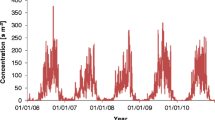Abstract
A 1-year time series of fungal spore concentrations has been used to calibrate an artificial neural network for the estimation of Alternaria and Pleospora concentrations associated to observed meteorological variables. Analysis of the results revealed that the daily average values of these meteorological variables are suitable to predict with high confidence the number of fungal spores that are actually observed. The calibrated neural network has also been used randomizing each single input parameter in order to evaluate which meteorological variable contributes more to the formation and the depletion of the selected fungal spores. Emphasis is given to the possibility of using the proposed model for operational activities, predicting the future spore concentrations on the basis of meteorological forecasts.






Similar content being viewed by others
References
Abdel Hameed, A. A. (2005). Vegetation: A source of air fungal bio-contaminant. Aerobiologia, 21, 53–61.
Coppola, E., Grimes, D. I. F., Verdecchia, M., & Visconti, G. (2006). Validation of improved TAMANN neural network for operational satellite-derived rainfall estimation in Africa. Journal of Applied Meteorology, 45, 1557–1572.
Elman, L. J. (1990). Finding structure in time. Cognitive Science, 14, 179–211.
Grimes, D. I. F., Coppola, E., Verdecchia, M., & Visconti, G. (2003). A neural network approach to real-time rainfall estimation for Africa using Satellite data. Journal of Hydrometerology, 4, 1119–1133.
Hecht-Nielsen, R. (1991). Neurocomputing. Reading, Mass.: Addison Wesley.
Hirst, J. M. (1952). An automatic volumetric spore trap. Annals of Applied Biology, 39, 257–265.
Hjelmroos, M. (1993). Relationship between airborne fungal spore presence and weather variables. Grana, 32, 40–47.
Kurkela, T. (1997). The number of Cladosporium conidia and the air in different weather conditions. Grana, 36, 54–61.
Lonbladd, L., Peterson, C., & Röngvaldsson, T. (1992). Pattern recognition in High Energy Physics with Artificial Neural Network – Jetnet 2.0. Computer Physics Communications, 167–182.
Lyon, F., Kramer, C. L., & Eversmeyer, M. G. (1984). Variation of airspora in the atmosphere due to weather condition. Grana, 23, 177–181.
Mandrioli, P., Comtois, P., & Levizzani, V. (1998). Methods in aerobiology (pp. 79–82). Bologna: Pitagora Editrice.
Tariq, S. M., Mattews, S. M., Stevens, M., & Hakim, E. A. (1996). Sensitization to Alternaria and Cladosporium by the age of 4 years. Clinical and Experimental Allergy, 26, 794–798.
Troutt, C., & Levetin, E. (2001). Correlation of spring spore concentrations and meteorological conditions in Tulsa, Oklahoma. International Journal of Biometeorology, 45, 64–74.
Author information
Authors and Affiliations
Corresponding author
Rights and permissions
About this article
Cite this article
Angelosante Bruno, A., Pace, L., Tomassetti, B. et al. Estimation of fungal spore concentrations associated to meteorological variables. Aerobiologia 23, 221–228 (2007). https://doi.org/10.1007/s10453-007-9066-y
Received:
Accepted:
Published:
Issue Date:
DOI: https://doi.org/10.1007/s10453-007-9066-y




